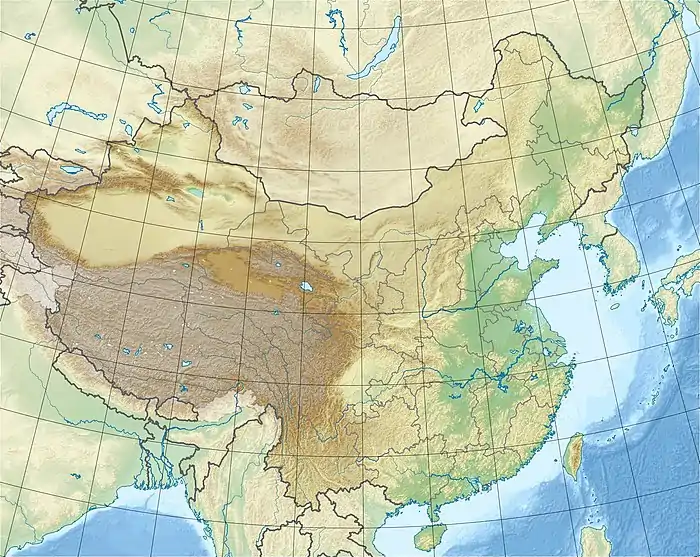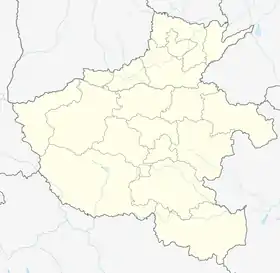| Dazhang Formation | |
|---|---|
| Stratigraphic range: | |
| Type | Geological formation |
| Underlies | Tantou Formation |
| Overlies | Gaoyugou Formation |
| Thickness | 373.2 m |
| Lithology | |
| Primary | Marl, oil shale, claystone and glutenite |
| Location | |
| Coordinates | 33°23′N 111°07′E / 33.39°N 111.11°E[1] |
| Region | Henan |
| Country | |
| Extent | Tantou Basin |
 Dazhang Formation (China)  Dazhang Formation (Henan) | |
The Dazhang Formation (simplified Chinese: 大章组; traditional Chinese: 大章組; pinyin: Dàzhāng zǔ) is a geologic formation in China. It preserves fossils dating back to the late Paleocene, including those of plants and mammals.[2] The formation is primarily composed of interbedded marl, oil shale, claystone and glutenite. Depending on the section, the color of the mudstone may vary from green, red-brown or gray-black.[1]
Dating
Comprehensive comparison of the lithology and stratigraphy suggests the Dazhang Formation was deposited during the late Paleocene. This dating is further supported by fossil evidence, as standard Paleocene fossils such as those of the snails Parhydrobia xiaohegouensis and Opeas guangdongensis, and anagalid mammals. Palynological evidence based on large amounts of Paleocene palynomorphs (including Proteaceae and Ulmaceae) also supports a late Paleocene age for this formation.[1]
Depositional environment
Judging from the lithology and absence of evaporative salt debris, the Dazhang Formation is believed to have represented delta and semi-deep lake environments, with a mild and humid climate during deposition. Palynology indicates the vegetation of the Dazhang Formation was primarily a mixed forest of coniferous and broadleaf deciduous trees within warm and temperate conditions, with broadleaf deciduous trees being dominant. Using the coexistence approach, the mean annual temperature has been estimated at 11.8–19.6 °C, with the mean temperatures of the warmest and coldest months at 19.8–28 °C and 3.9–5.9 °C respectively. Mean annual precipitation is believed to be 793.9–1389.4 mm.[1]
Fossil content
Mammals
| Mammals reported from the Dazhang Formation | |||||
|---|---|---|---|---|---|
| Genus | Species | Presence | Material | Notes | Images |
| Pseudictopidae | Wangpo Village.[3] | Mandible.[3] | An anagaloid. | ||
| Yuesthonyx | Y. tingae | Wangpo Village.[3] | Skull elements.[3] | A tillodont. | |
Plants
| Plants reported from the Dazhang Formation | |||||
|---|---|---|---|---|---|
| Genus | Species | Presence | Material | Notes | Images |
| Alnipollenites | A. metaplasmus | Pollen.[4] | |||
| A. verus | Pollen.[4] | ||||
| Aquilapollenites | A. granibaculus | Pollen.[4] | An angiosperm. | ||
| Araliaceoipollenites | Pollen.[4] | A magnoliopsid. | |||
| Atlantopollis | Pollen.[4] | An angiosperm. | |||
| Beaupreaidites | B. aggregatus | Pollen.[4] | A member of Proteaceae. | ||
| B. striatus | Pollen.[4] | A member of Proteaceae. | |||
| Carpinipites | Pollen.[4] | ||||
| Caryapollenites | Pollen.[4] | ||||
| Cupuliferoipollenites | C. fusus | Pollen.[4] | |||
| C. oviformis | Pollen.[4] | ||||
| Cyathidites | Spores.[4] | A pteridopsid. | |||
| Echitriporites | E. trianguliformis | Pollen.[4] | A member of Proteaceae. | ||
| Ephedripites | Pollen.[4] | An ephedrale. | |||
| Euphorbiacites | Pollen.[4] | ||||
| Fraxinoipollenites | Pollen.[4] | A magnoliophyte. | |||
| Ginkgo | G. henanensis | 30 leaves.[5] | A ginkgoale. | ||
| Liliacidites | Pollen.[4] | A member of Liliales. | |||
| Liquidambarpollenites | Pollen.[4] | A member of Altingiaceae. | |||
| Magnolipollis | Pollen.[4] | ||||
| Momipites | M. corylus | Pollen.[4] | A magnoliopsid. | ||
| Osmundacidites | Spores.[4] | A pteridopsid. | |||
| Paraalnipollenites | P. confusus | Pollen.[4] | |||
| Pinuspollenites | Pollen.[4] | A conifer. | |||
| Plicapollis | P. granulatus | Pollen.[4] | |||
| Polypodiaceoisporites | P. triangulus | Spores.[4] | |||
| Propylipollis | P. sp. | Pollen.[4] | A member of Proteaceae. | ||
| Proteacidites | P. adenanthoides | Pollen.[4] | A proteale. | ||
| P. liaoningensis | Pollen.[4] | A proteale. | |||
| P. microverrucatus | Pollen.[4] | A proteale. | |||
| P. tenellus | Pollen.[4] | A proteale. | |||
| P. tenuispinosus | Pollen.[4] | A proteale. | |||
| Quercoidites | Pollen.[4] | Oak pollen. | |||
| Rhamnacidites | Pollen.[4] | A buckthorn. | |||
| Rhoipites | R. dolium | Pollen.[4] | A magnoliopsid. | ||
| Rutaceoipollenites | Pollen.[4] | A member of Rutaceae. | |||
| Salixipollenites | S. minor | Pollen.[4] | |||
| Sapindaceidites | Pollen.[4] | A soapberry. | |||
| Sequoiapollenites | Pollen.[4] | A conifer. | |||
| Taxodiaceapollenites | T. bockwitzensis | Pollen.[4] | A conifer. | ||
| T. hiatus | Pollen.[4] | A conifer. | |||
| Ulmipollenites | U. minor | Pollen.[4] | |||
| U. undulosus | Pollen.[4] | ||||
| Ulmoideipites | U. krempi | Pollen.[4] | A magnoliopsid. | ||
| U. tricostata | Pollen.[4] | A magnoliopsid. | |||
References
- 1 2 3 4 Su, Li-Fei; Zhang, Qian-Qian; Sun, Yan-Kun; Zhang, Shao-Liang; Smith, Thierry; Li, Cheng-Sen (2022-11-28). "New evidence of the emergence of the East Asian monsoon in the early Palaeogene". Scientific Reports. 12 (1): 20471. Bibcode:2022NatSR..1220471S. doi:10.1038/s41598-022-24298-z. ISSN 2045-2322. PMC 9705385. PMID 36443349.
- ↑ Tong, YS; Wang, JW (1980). "Subdivision of the upper cretaceous and lower tertiary of the Tantou basin, the Lushi basin and the Lingbao Basin of W Henan". Vertebrata PalAsiatica (in Chinese) (1): 21–27. doi:10.19615/j.cnki.1000-3118.1980.01.004. ISSN 1000-3118.
- 1 2 3 4 YongSheng, Tong; Wen, WANG Jing; JingFang, F. U. (2003-03-15). "Yuesthonyx, a new tillodont (Mammalia) from the Paleocene of Henan". Vertebrata PalAsiatica. 41 (1): 55. ISSN 2096-9899.
- 1 2 3 4 5 6 7 8 9 10 11 12 13 14 15 16 17 18 19 20 21 22 23 24 25 26 27 28 29 30 31 32 33 34 35 36 37 38 39 40 41 42 43 44 Da-ning, Wang; Ying-niang, Sun Xiu-yu and Zhao (1984-04-20). "The Paleocene-Eocene Palynoflora from the Tantou Basin in West Henan". Journal of Integrative Plant Biology (in Chinese). 26 (4). ISSN 1672-9072.
- ↑ Li, Qijia; Niu, Bingshan; Liu, Yusheng Christopher; Jia, Hui; Li, Yu; Xu, Li; Quan, Cheng (2023-09-17). "Analysis of leaf economics sheds light on the heterophylly and ecological strategies of Paleocene Ginkgo leaves from Henan Province, China". Palaeogeography, Palaeoclimatology, Palaeoecology. 630: 111816. Bibcode:2023PPP...63011816L. doi:10.1016/j.palaeo.2023.111816. ISSN 0031-0182. S2CID 262060653.